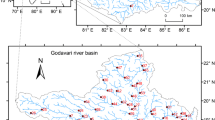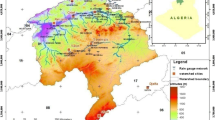Summary
In a previous study the authors have estimated the probable maximum precipitation (PMP) for a 2-day duration using Hershfield's formulaX PMP =X n +k m σ n for stations in the southern Indian region. In this paper, the study is extended to estimate the PMP for stations in the north Indian region, north of 20°N. Maximum annual 2-day rainfall data for an 80-year period, from 1901, were obtained for 286 stations in the region. A mathematical relationship between the frequency factor (k m ) and the mean annual extreme rainfall (X n ) was developed to bek m = 18.15 exp (−0.0448X n ). This equation was used to obtaink m for different values ofX n and, subsequently, to estimate 2-day PMP values for the 286 stations. Using these PMP estimates, a generalised chart was prepared, showing the spatial distribution of 2-day PMP. It was found that 2-day PMP over the north Indian region varied from 60 cm to 130 cm, and the average ratio of the 2-day PMP to the highest observed 2-day rainfall was found to be 1.91. The results show that there have been instances when almost 2-day point PMP have occurred at some of the stations in the region. These results indicate that the statistically estimated PMP rainall are not therefore, mere theoretical estimates, but they can occur under optimum meteorological conditions.
Similar content being viewed by others
References
Bruce, J. P., Clark, R. H., 1966:Introduction to Hydrometeorology. New York: Pergamon, 319 pp.
Dhar, O. N., Kulkarni, A. K., Mandal, B. N., 1984: The most severe rainstorm of India — a brief appraisal.Hydrological Sciences J. 29, 219–229.
Dhar, O. N., Kulkarni, A. K., Rakhecha, P. R., 1981: Probable maximum point rainfall estimation for the southern half of the Indian peninsula.Proc. Ind. Acad. Sci. (Earth Planet. Sci.),90, 39–46.
Dhar, O. N., Rakhecha, P. R., Mandal, B. N., 1980: Rainstorms which contributed greatest areal rain depths.Arch. Met. Geoph. Biokl. Ser. A 29, 119–130.
Dhar, O. N., Rakhecha, P. R., Mandal, B. N., Sangam, R. B., 1982: Was the July 1981 rainstorm over Rajasthan unprecedented?PAGEOPH 120, 483–494.
Hershfield, D. M., 1961: Estimating the probable maximum precipitation.J. Hyd. Div., Am. Soc. of Civil Eng. 87, HY, 99–116.
Hershfield, D. M., 1965: Method for estimating probable maximum precipitation.J. Am. Water Works Assoc. 57, 965–972.
Indian Institute of Tropical Meteorology (IITM), 1989:Probable maximum precipitation atlas. IITM publ.
Kendall, M., Stuart, A., 1976:The Advanced Theory of Statistics, vol. 3. London: Charles Griffin, 557 pp.
Mejia, G., Villegas, F., 1979: Maximum precipitation deviations in Colombia.Proc. Third Conf. on Hydrometeorology. Boston: Am. Met. Soc.
Myers, V. A., 1967: Meteorological estimation of extreme precipation for spillway design floods.U.S. Weather Bureau, WBTM, Hydro. 5, 1–29.
Rakhecha, P. R., Deshpande, N. R., Soman, M. K., 1992: Probable maximum precipitation for a 2-day duration over the Indian peninsula.Theor. Appl. Climatol. 45, 277–283.
Rakhecha, P. R., Mandal, B. N., Kulkarni, A. K., Sangam, R. B., 1993: A Hydrometeorological analysis of the severe rainstorm of 20–22 September, 1900 over Gangetic West Bengal.Adv. Atmos. Sci. 10, 113–120.
Sarma, P. B. S., Kailashnathan, K., Rao, G.G.S.N., 1975: Analysis of maximum precipitation over coastal Andhra Pradesh.Proc. Second World Congress on Water Resources 3, 471–487.
World Meteorological Organisation, 1966:Climatic Change. WMO Tech. Note No. 79, 80 pp.
World Meteorological Organisation, 1969:Estimation of Maximum Floods. Tech. Note No. 98, WMO No. 232, TP-126.
World Meteorological Organisation, 1970:Guide to Hydrometeorological Practices. WMO No. 168, TP-82.
World Meteorological Organization, 1986:Manual for Estimation of Probable Maximum Precipitation. Operational Hydrology Report No. 1, WMO No. 332, 96–108 (Second Edition).
Author information
Authors and Affiliations
Additional information
With 4 Figures
Rights and permissions
About this article
Cite this article
Rakhecha, P.R., Soman, M.K. Estimation of probable maximum precipitation for a 2-day duration: Part 2 — north Indian region. Theor Appl Climatol 49, 77–84 (1994). https://doi.org/10.1007/BF00868192
Received:
Revised:
Issue Date:
DOI: https://doi.org/10.1007/BF00868192




